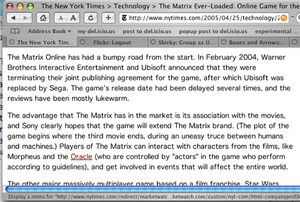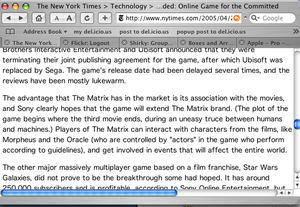NY Times Mistake Shows Utility of Semantic Framework
Reading the online edition of the New York Times just before leaving work this afternoon, I came across an ironic mistake that shows the utility of a well developed semantic framework that models the terms and relationships in defingin different editorial contexts. In an article discussing the Matrix Online multiplayer game, text identifying the movie character the Oracle mistakenly linked to a business profile page on the company of the same name. In keeping with the movie’s sinister depictions of technology as a tool for creating deceptive mediated realities, by the time I’d driven home and made mojitos for my visiting in-laws, the mistake was corrected…
Ironic humor aside, it’s unlikely that NYTimes Digital editors intended to confuse a movie character with a giant software company. It’s possible that the NYTimes Digital publishing platform uses some form of semantic framework to oversee automated linking of terms that exist in one or more defined ontologies, in which case this mistake implies some form of mis-categorization at the article level,invokgin the wrong ontology. Or perhaps this is an example of an instance where a name in the real world exists simultaneously in two very different contexts, and there is no semantic rule to govern how the system handles reconciliation of conflicts or invocation of manual intervention in cases when life refuses to fit neatly into a set of ontologies. That’s a design failure in the governance components of the semantic framework itself.
It’s more likely that the publishing platform automatically searches for company names in articles due for publication, and then creates links to the corresponding profile information page without reference to a semantic framework that employs contextual models to discriminate between ambiguous or conflicting term usage. For a major content creator and distributor like the NY Times, that’s a strategic oversight.
In this screen capture, you can see the first version of the article text, with the link to the Oracle page clearly visible:
Mistake:
The new version, without the mistaken link, is visible in this screen capture:
New Version:
Related posts:
Category: Semantic Web | Tags: media, nytimes, semantics, semanticweb Comments Off Comment »